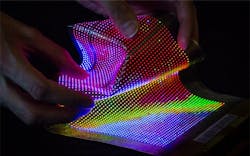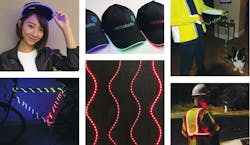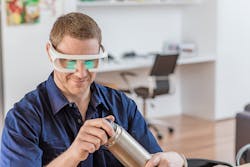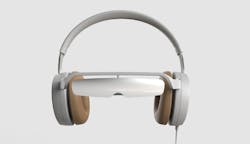Photonics Applied: Wearable Photonic Technology: Photonics gets up close and personal: Advancing wearable technology with light
Many wearable devices for displaying information or tracking your personal fitness or medical parameters use electrical signals, chemical reactions, or materials-deformation technology. But many wearables depend on light: the emission of light directly into the skin for the purposes of healing, monitoring, and even predicting dangerous medical conditions; illuminated clothing as a personal art statement or safety device; and even photovoltaic wearables that absorb rather than emit light for charging your smartphone or other wearable device.
ABI Research (Oyster Bay, NY) forecasts that enterprise wearables including smartwatches, smartglasses, and wearable scanners will top $60 billion by 2022 from their comfortable $10.6 billion in sales in 2017. Incredibly, IDTechEx (Cambridge, England) forecasts the wearable device market to reach more than $150 billion by 2027.
It can be difficult to classify a wearable as belonging to the photonics category—theoretically, the laser-marked tag or light-emitting diode (LED) collar light for your pet would fit the description. What follows is a selection of somewhat more sophisticated and technology-intensive photonic wearables that increase the plausibility of these multi-billion-dollar consumer forecasts.
Personal safety and expressive displays
Although not yet commercialized in wearable form, microLED technology companies are not only exploring its use in visual displays, but also for personal wearable displays and for fingerprint identification and gesture recognition because of the ability of its tiny light-center pixels—from 1 to 10 μm in diameter, spaced as close as 1 mm apart, and more energy-efficient than liquid-crystal displays (LCDs) and organic light-emitting diodes (OLEDs)—to be fabricated on flexible substrates that can also incorporate electronic circuits for sensing capability (see Fig. 1). Companies like Apple and Oculus are betting on the technology, and have each acquired microLED companies.
Luminit (Torrance, CA) has even designed micro-diffusing technology to improve the visual appeal of pixelated microLEDs when viewed up close. The diffusers consist of holographically recorded light shaping diffuser (LSD) microstructures embedded on polyester or polycarbonate film that, when placed as close as 10 μm to the microLED surfaces, spread the illumination into custom beam angles depending on the LSD structure selected.
A wearable product now being commercialized, however, uses optical-fiber technology developed by Corning Incorporated (Corning, NY) and named Fibrance, as described in Laser Focus World back in 2014. Rather than guiding light with minimal loss to a remote destination, Fibrance is instead lossy fiber that emits light uniformly along its length and takes light to places that bulkier or distributed microLED or OLED lighting options cannot go.
"Corning's business model has been to sell millions of kilometers of optical fiber to large companies, but our aim is to sell several-meter-long lengths of fiber into millions of consumer, wearable, gaming, and automotive applications," says Mario Paniccia, CEO and founder of newly formed Silicon Valley-based Versalume—meaning "versatile lumens."
Versalume's solution integrates the laser, electronics, fiber, batteries, and software in a savvy industrial design that allows customers to focus on the application and readily take their lighted products to market. The single-color products have either red, green, or blue (639/515/450 nm) lasers. In addition, there is a Bluetooth-controlled RGB smart module with an iOS app that includes sensors such as an accelerometer, barometer, temperature monitor, and gyroscope, and can operate in continuous-wave, blink, fade, or beat–to-music mode.
Their solutions come with either FC- or LC-connectorization options. The fiber itself has a core diameter of 170 μm with a polymer cladding, is <10 mm bend-radius-capable, and comes in diffusion lengths from 0.5 to more than 50 m. The large numerical aperture (0.53) allows for low-loss coupling from visible, near-IR, and UV laser diodes.
Versalume's module confronts one of the biggest challenges of wearable lighting: the size and weight of the power/controller module used to illuminate the fiber. After all, most of the LED- or electroluminescent-panel-based t-shirts use two AA batteries—not exactly a comfortable form factor (and please disconnect before washing).
Although it has been challenging to convince consumers that "laser"-illuminated optical fibers are safe to the eyes and body, Paniccia is overwhelmed by the acceptance of their slim, flexible product not only as a wearable for personal expression and display on hats, as lighted jewelry, or as a novel fashion statement, but he's also working to incorporate the neon-like fibers into automotive and heads-up displays, gaming PCs, and architectural lighting, and is spearheading the development of lightweight, low-power-consumption modules to improve the safety of construction/highway workers and evening cycling/dog-walking enthusiasts (see Fig. 2).Health and fitness monitoring
You've heard about spectroscopy on your cell phone. The next breakthrough: spectroscopy performed (noninvasively) on your skin rather than pricking yourself to draw blood and test your glucose levels, for example. Writing in Scientific Reports, researchers at the University of Texas at Dallas (Richardson, TX) and EnLiSense (Allen, TX) have developed a sensor that can be worn on your wrist or other area of the skin to monitor your glucose, cortisol, and a number of other stress and health indicators.1
The device uses zinc-oxide (ZnO) thin films on nanoporous polyamide substrates to determine protein and cortisol levels in human sweat that dictate certain health conditions. As confirmed by Fourier-transform infrared spectroscopy (FTIR) and dynamic light scattering (DLS) optical methods, the sensor is suitable for consumer applications.
Also specific to blood glucose sensing, researchers at the University of Frankfurt in Germany are using photoacoustic spectroscopy (PAS)—a combination of a windowless ultrasound between 50 and 60 kHz and an external-cavity tunable quantum-cascade laser that spans 1000 to 1245 cm-1—to obtain a mid-infrared spectrum when absorption of glucose molecules creates a sound signature that records sugar levels in skin cells.
To monitor ultraviolet (UV) exposure, brain activity, and fluorescent biomarkers placed under the skin to monitor disease progression, both Laser Focus World and BioOptics World editors have published news stories on a solar-powered thumbnail-sized UV dosimeter, a headband-sized functional near-IR spectroscopy device, and a wearable microscope that can analyze the fluorescent signals as they change in response to underlying conditions in a point-of-care setting.
But perhaps the ultimate in photonic wearables for personal health and safety is a directionally sensitive, real-time radiation dosimeter.1Proposed by researchers at La Trobe and RMIT Universities (both in Bundoora, Victoria, Australia) for individuals working with radioactive materials, the wearable uses a circular array of eight cadmium-zinc-tellurium (CdZnTe) detectors and a simple computational algorithm (performed by a small microcontroller) that can estimate the direction of a 10 microcurie (μCi) cesium-based radioactive source to within 2° in about 7 seconds.
In addition to photonic wearables that monitor physical health and fitness, light can also heal. Researchers at Biomimetic Membranes and Textiles (Dübendorf, Switzerland) developed a washable, rugged photonic cloth that fights off jaundice in newborn babies by delivering blue light from LEDs into 160-μm-diameter polymer optical fibers wrapped in silk fabric. A blue-light wearable from Royal Philips (Amsterdam, Netherlands)—that has been available in Europe for several years—recently received U.S. FDA approval to treat mild psoriasis. And Re-Timer glasses (www.re-timer.com) manufactured in Adelaide, Australia retail for $299 and are ultrathin wearable glasses that deliver 500 nm green-blue light that the inventors say, when worn for about 60 minutes a day, can improve sleep, reduce jet lag, and allow shift workers to better manage their alertness levels during nighttime working hours (see Fig. 3).Beyond Kinect
Remember when the Microsoft Kinect systems came out and everyone gathered in your living room to act like children as they used physical gestures to play a round of golf or tennis, or drive a sports car? The idea was to immerse your physical body in a state of altered reality, dictated by IR laser diodes that translated your movements into the visual motions of avatars on a display screen.
Less than a decade later (the first-generation Kinect systems were launched in 2010), the buzzwords augmented reality/virtual reality/mixed reality (VR/AR/MR) are now moving beyond Kinect and bringing the action even closer to your physical body and, more importantly, closer to your brain and thought processes through ever-smaller wearable headsets or eyeglasses.
At the 2018 Consumer Electronics Show (CES) in Las Vegas, NV, Kopin (Westborough, MA) introduced its AR/VR Eagle wearable home theater, co-developed with Pico Interactive, that produces the equivalent of an 80-in. high-definition (1280 × 720 resolution) video screen viewed at a distance of 10 ft. (without obscuring the viewers' surrounding vision and awareness) by incorporating a 720-pixel, 0.49-in. diagonal OLED microdisplay in a slim headset (see Fig. 4).Recently, Innovega (Bellevue, WA) moved a step beyond the otherwise bulky glasses for AR/VR viewing by offering the ultimate wearable altered-reality experience. The January 2018 press release says, "The family of Innovega patents will allow wearers to merge the digital and real world, providing an uncompromising augmented and mixed reality experience that goes beyond anything else that is available. The system combines contact lenses (or surgically implanted lenses) with stylish glasses. This combination gives the user a discreet, high-performance entertainment and information experience. For patients with vision correction needs, the prescription can be applied to the contact or surgically implanted lens."
The Innovega patents are reminiscent of those filed by Google for smart contact lenses that basically implant a computer into your eye.
Of course, while many wearable technologies are commercialized or in development, still many more have not reached the consumer market. For example, optical diabetes monitoring ranges from Raman spectroscopy methods to exploration of optical coherence tomography (OCT)-based technologies. However, to date, I could not find a single optical blood-sugar-monitoring technology that is available to the general public. Given the accelerated pace of lidar in autonomous vehicles, 3D sensing for smartphones, and successful photonic (LED)-based medical devices like pulse oximeters from companies like Masimo (Irvine, CA), I have no doubt that photonic wearable technologies still relegated to the prototype stage will reach consumers sooner than we think.
REFERENCE
1. H. Huu Le et al., Int. J. Phys. Math. Sci., 11, 5, 202–205 (2017).
About the Author

Gail Overton
Senior Editor (2004-2020)
Gail has more than 30 years of engineering, marketing, product management, and editorial experience in the photonics and optical communications industry. Before joining the staff at Laser Focus World in 2004, she held many product management and product marketing roles in the fiber-optics industry, most notably at Hughes (El Segundo, CA), GTE Labs (Waltham, MA), Corning (Corning, NY), Photon Kinetics (Beaverton, OR), and Newport Corporation (Irvine, CA). During her marketing career, Gail published articles in WDM Solutions and Sensors magazine and traveled internationally to conduct product and sales training. Gail received her BS degree in physics, with an emphasis in optics, from San Diego State University in San Diego, CA in May 1986.



